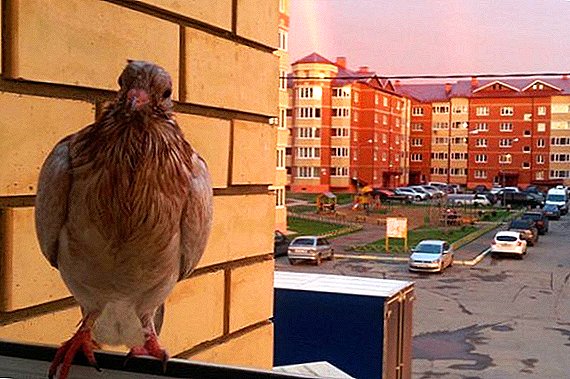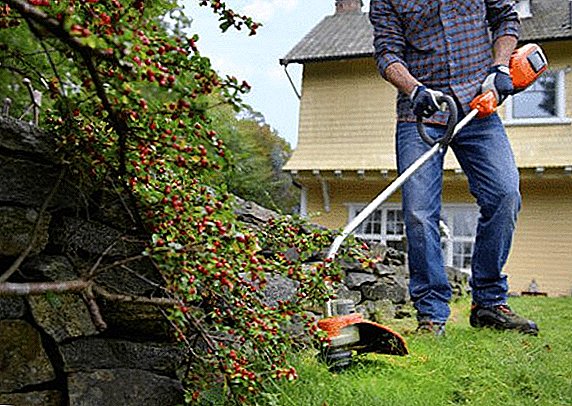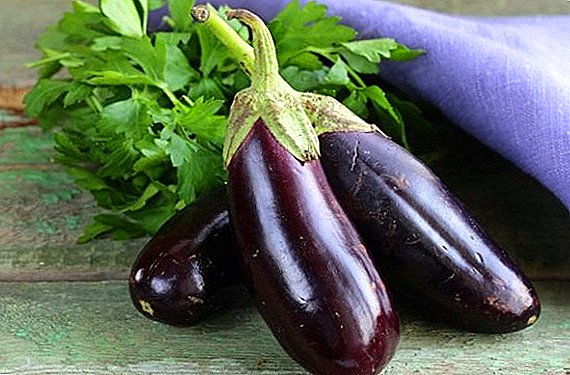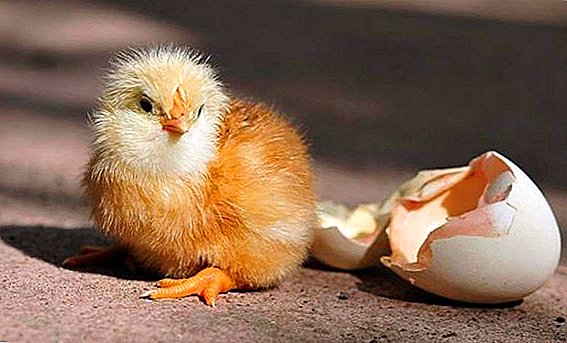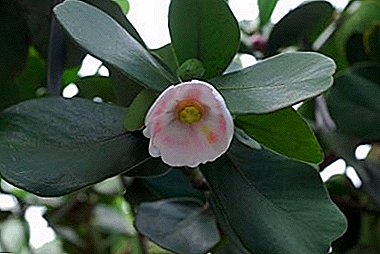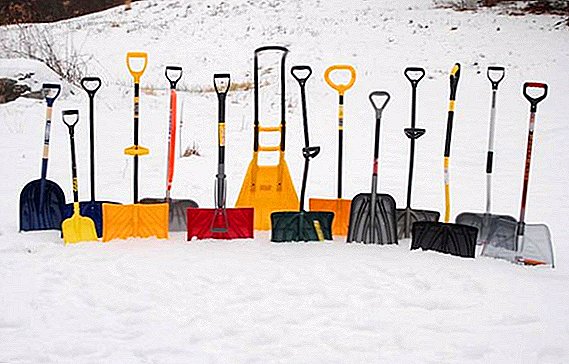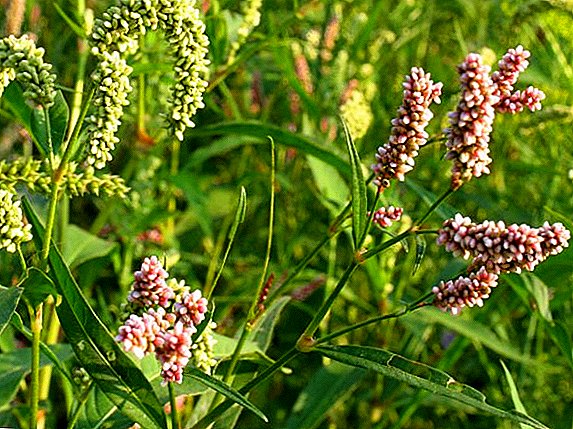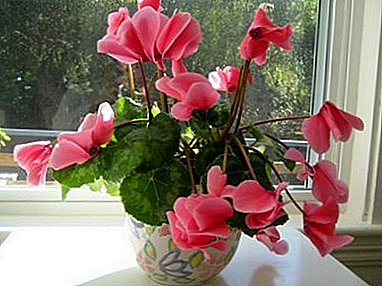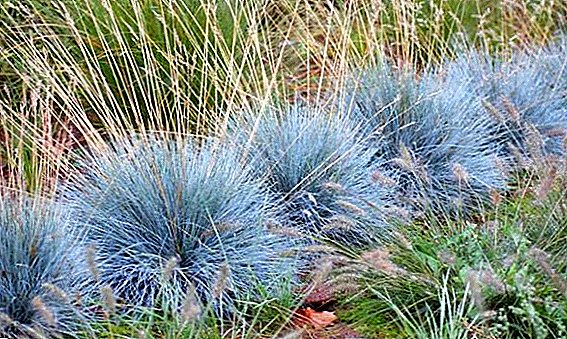 Bluegrass fescue - an unusual plant with high decorative and exotic. It is a compact hemispherical undersized bush of the original form.
Bluegrass fescue - an unusual plant with high decorative and exotic. It is a compact hemispherical undersized bush of the original form.
Interesting color, coupled with the endurance of the plant and unpretentiousness allows him to be a favorite of landscape designers and people who want to make beautiful landscape compositions in his garden.
Gray-Fescue: Description
Fescue decided to refer to the family of cereals. Distribution in nature - temperate and subtropical zones. As an artificial ornamental plantings, the plant “spread out” in all climatic zones from northern to tropical. Of all the types of fescue, gray is most loved by garden designers, both professionals and amateurs. Due to the color of leaves, the plant got its name, its variants: ashy, blue fescue. Depending on weather conditions, the color may vary, but the plant does not lose its decorative effect.
Did you know? The name "festuca" fescue worn back in ancient Roman times, but its true meaning did not reach its contemporaries. The popular name "fescue" appeared because of the similarity of an ornamental shrub with a plant of the same family - oats.
The plant is a lush bush with a height of 20 to 60 centimeters, the leaves are narrow, twisted into a tubule. Modified in this way, they save water. Evergreen leaves form round dense bushes. The roots are thick, small in size.
It blooms in early or mid-summer with inconspicuous light brown small flowers. Formed after flowering seeds are very small.  Without replanting in one place, fescue can grow 5-10 years. Divide and transplant curtain after five years; if the plant has dried or frozen, then earlier.
Without replanting in one place, fescue can grow 5-10 years. Divide and transplant curtain after five years; if the plant has dried or frozen, then earlier.
As a soil cover to protect it from drying out and weeds, fescue is ideal. Serving this goal, it creates a unique decorative effect that persists throughout the season.
There are many garden forms of fescue, they are different foliage and color.
Growing conditions
Fescue - big lovers of the sun, almost all of them are cold-resistant and not afraid of frost. It is advisable to buy copies, bred in the area and acclimatized to its conditions, so that there are no unpleasant surprises after the winter season. The disadvantage is that clumps degenerate quite quickly. After two or three years, the plant has to be divided, because the center of derninki dies. The advantage is that it grows quite quickly, spreading wide, and already in the first year it acquires a decent look that can beautify any part of the landscape with its exquisiteness.
sunlight
Fescue will be grateful for the most hot areas of the garden, where she feels fine. It is not afraid of high temperatures - gardeners use this property, settling it on alpine hills on the south side.
The plants that also love sunlight include edelweiss, liatris, thyme, awl-shaped phlox, young, carnation.The plant is not friendly with shadow or even penumbra, besides it does not tolerate drafts. You should not risk and plant light-loving "hedgehogs" in unsuitable conditions for them. Without light, they can lose their beautiful blue color.

Soil for growing plants
This unusual plant does not require humus or other nutrients. The soil should be dry or fast drying, loose and breathable. Stagnant water should in no case be. Often additionally used drainage.
Fescue does not need nutritious soil, regular watering, careful feeding. Best of all, she will feel herself on rocky, dry soil. Only in the conditions of suitable soil and abundant sunlight this plant will thank its owner with a beautiful gray color, abundant flowering and an exquisite unusual look of the bush.
Terms and rules of landing
As unpretentious itself fescue, and simple process of its landing. Compliance with simple conditions will ensure success in the cultivation of perennial.
Gray fescue breeds mainly by vegetative means; cultivation from seeds is also practiced. 
Seed propagation
Seed propagation method is used for species. In this case, the seeds:
- sown in the ground;
- planted on seedlings;
- use plants resulting from self-seeding.
Important! The fescue plants that are planted in the ground and grown by seedlings are equally well adapted, but the first ones will germinate somewhat faster.
If you decide to purchase seeds to plant funny “hedgehogs” in your garden, you should give preference to specialized outlets.  Seed material should be chosen from those varieties that are acclimatized to the area and have a certain level of frost resistance.
Seed material should be chosen from those varieties that are acclimatized to the area and have a certain level of frost resistance.
Important! Only natural species are subject to seed reproduction. Artificial fescue, with this method of reproduction lose characteristics of the variety.If we neglect this rule, there is a risk to get a plant that is not adapted to local conditions, which will freeze out after the first wintering.
Seed planting It is produced after warm weather is set in spring or before cold weather comes in autumn.
- Before planting seeds that were collected independently, be sure to pickle in a solution of potassium permanganate. If you have purchased seed from a reputable seller, especially if there is an indication on pre-treatment on the packaging, this is not necessary.
- It should be planted on 5-7 seeds in each well, so that they quickly formed a lush hummock.
- The hole should not be too deep, a maximum of 5 centimeters.
- Planting seeds in the ground, you need to fill them with soil mixture, compacted and watered.
- The interwell distance can be from 10 centimeters, depending on the desired result.
- After the appearance of the first shoots that will appear in a few weeks, semicircular lush hummocks will very soon form.
 Planting seeds for seedlings occurs in early March, so that in the first half of May to plant fallen and grown bushes.
Planting seeds for seedlings occurs in early March, so that in the first half of May to plant fallen and grown bushes.- The substrate should be light, airborne and permeable; sowing the seeds, do not sprinkle them, and moistened with a spray.
- Cover with cellophane or glass, the container should be placed in a warm bright place. Such a greenhouse will allow seedlings to roll in a few days.
- So that the seedlings are not thinner and not dead, the container will need to be rearranged to a place where it is cooler, however, it must be light.
- After the formation of two true leaves, seedlings to obtain a lush bush dive groups in separate containers.
- After the weather has settled, most often it happens on the May holidays, the seedlings need to be planted in the ground.
Important! With great caution should be treated to moisture: excess moisture will lead to decay and death of the roots.
Vegetative
Most often use the vegetative method of reproduction during transplantation and separation of overgrown bushes.  This should be done either in the spring before the beginning of the crop rotation, or in the autumn when the plants are preparing for winter.
This should be done either in the spring before the beginning of the crop rotation, or in the autumn when the plants are preparing for winter.
- Bushes that have grown heavily, and it's time to plant them, should be divided into parts.
- The resulting delenki need to land as separate plants.
- The core, which has become unusable and due to which the decorative appearance of the whole bush has been broken, is removed without using it.
Important! Adults, not less than two years of age, share bushes.
To give the plant additional winter-resistance, the mother bush should be dug with a clod of earth, planted in a container and placed in a lighted but cold place, for example, a greenhouse. At the same time it is necessary to exclude any dampness in order to avoid the destruction of the bush.
In early spring, when it comes time to plant fescue, the curtain is supposed to be divided, the dumplings are planted in containers in a mixture of soil with humus and sand. Planted in the ground should be in early summer. Having gone through a similar hardening, they will be much stronger and more quickly gain green mass. 
How to care for a plant in the garden
Bluegrass fescue has many advantages: not only is it completely undemanding to soils, it tolerates both high and low temperatures, it almost does not need watering and top dressing, and to preserve the decorative look of the bush is not difficult.
Important! Immunity in fescue is very strong, separately growing specimens do not get sick with anything. Frequently, however, there are cases when "neighbors" in a lawn mixture or decorative composition infect a silver bush.Undoubtedly, gray-light fescue is one of the leaders among the unassuming and at the same time ornamental plants, planting and caring for which are minimal and do not require special knowledge.

Watering
Excess moisture - this is something that absolutely can not be allowed in the care of fescue. The roots begin to suffer: they rot and die off, as a result of which the whole plant dies.
Water the bushes should be very moderate, only if necessary: let there be little better water than too much.
Important! Winter frosts tolerate fescue well, its main enemy is autumn and spring waters, leading to rotting of its roots. It is also dangerous for her snow-free frosty winter.
Fertilizer rules
The fescue is completely undemanding to the soils: it is loamy, stony, sandy to its taste.  Only in the case of extreme nutritional needs, when the plant has become worse to grow and develop, is it permissible to further fertilize the soil in which it grows.
Only in the case of extreme nutritional needs, when the plant has become worse to grow and develop, is it permissible to further fertilize the soil in which it grows.
Fertilizers make organic or mineral, the dosage specified in the instructions can not be exceeded. Excess nutrients can adversely affect the decorative perennial.
You will be interested to learn more about mineral and organic fertilizers.
Pruning
When spring comes, the grass needs to be rid of depleted leaves and dead fragments, which will improve the appearance of the ornamental plant. This can be done both manually and using a rake, which, due to the rigidity of the leaves, will not cause damage to the aesthetic component of the fescue. After the bush blooms, it is necessary to cut the flower stalks to preserve the appearance. In the case when you need to collect the seeds, you should leave the largest flower stalks until full maturity.
Bluegrass fescue - a real decoration of any garden, which is quite easy to grow even for a beginner. The plant is hardy: it resists high temperatures with dignity, while it is frost-resistant. Growing conditions and care require minimal. The disadvantage is the impossibility of planting fescue on shaded areas, besides, it does not tolerate moisture. If the plantings are large, taking care of them can be quite time consuming, due to the need to periodically divide and rejuvenate curtains.


